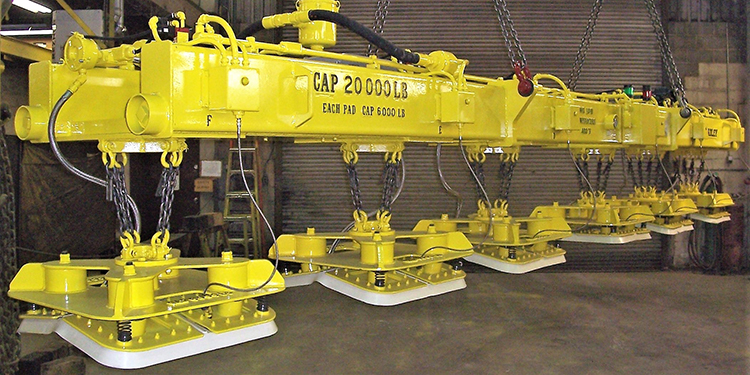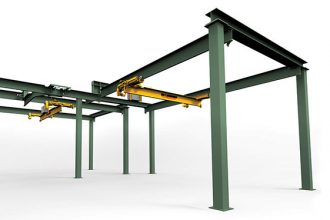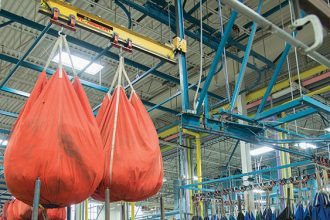Why Emergency Stops Are Required For Powered Below The Hook Devices

Operations utilizing overhead lifting and handling equipment often use below the hook devices to connect a load to the hook. There are a variety of below the hook attachments available in the market to accommodate a broad range of handling applications, such as loads that are unevenly shaped, exceptionally heavy, or unusually fragile. While some of these units (also known as end effectors) connect to a load mechanically or by gripping it, others require a power source in order to securely attach to an item. These electric below the hook devices include vacuum lifters that utilize an electric-powered pump and sealed pads to create a vacuum when connected to the load, and electrically powered magnets that generate a magnetic current to attach to ferrous objects.
Just as overhead cranes and hoists should be equipped with an emergency stop (E-STOP) or safety disconnect switch that independently cuts off the power to the equipment independently of the regular operating controls, powered below the hook devices should also be likewise outfitted. That’s because in a configuration that provides power to the below the hook device via an integrated overhead crane or hoist circuit, engaging an E-STOP for the hoist or crane could result in the powered lifting device being disengaged. This action would result in the load falling, which creates an extremely high risk of property damage, injury, or death.
Because of this risk, requirements for the application, installation, and usage of E-STOP or safety disconnect switches for powered below the hook devices are included in standards from the Occupational Safety and Health Administration (OSHA) and the American Society of Mechanical Engineers (ASME). These include the following:
- OSHA 1910.179(g)(5)(v) requires all cranes equipped with a powered lifting magnet to have an enclosed magnet circuit switch that can be locked in the open position, and a means to discharge the inductive load of the magnet.
- ASME B30.2 specifies that cranes used with lifting magnets must have a separate enclosed magnet circuit switch that can be locked in the open (or off) position. It also mandates that the magnet’s disconnect switch be connected to the power supply side of the crane’s disconnect switch.
- ASME B30.20 requires that when using a vacuum lifter in conjunction with a crane and hoist, the electrical power supply for the attachment shall be connected to either the power supply side of the crane disconnect or to an independent circuit. The same standard mandates that provisions be made for guarding a magnet control switch when it is in the lift position to prevent it from being accidentally turned off and releasing the load.
- ASME BTH-1, which details the minimum structural, mechanical, and electrical design criteria for below the hook lifting devices, specifies that hoisting equipment that uses an externally powered electromagnet be outfitted with a separate enclosed circuit switch with provisions for locking, flagging, and tagging the magnet’s power source in the open (off) position. It also requires a means for discharging the inductive energy of the lifting magnet, and that the lifting magnet disconnect switch be connected on the power supply side of the hoisting equipment’s disconnect switch.
In addition to these requirements, there are several key best practices recommended for the safe operation and use of electrically powered below the hook devices. These include:
- Ensure that every powered below the hook device is separated electrically from the crane or hoist circuit, as well as from the operation of the E-STOP function on both remote and push-button controls.
- Verify that a separate electrical circuit that includes independent branch circuit fusing between the conductor bar system and the below the hook device power cable is in place prior to operating the overhead handling system.
- Confirm that the proper circuitry has been installed on overhead cranes and hoists to ensure that the power supply to any electrified below the hook device remains uninterrupted during operation.
- Do not operate any overhead handling system with a powered below the hook device without first confirming that the attachment is in proper working condition. The attachment(s) should also be tested for both capacity and function on a regular basis.
Want more details about the safe installation and operation of below the hook devices? The Crane Manufacturers Association of America (CMAA) has published the CMAA Specification 80: Below-the-Hook Lifting Device Operator’s Manual.



